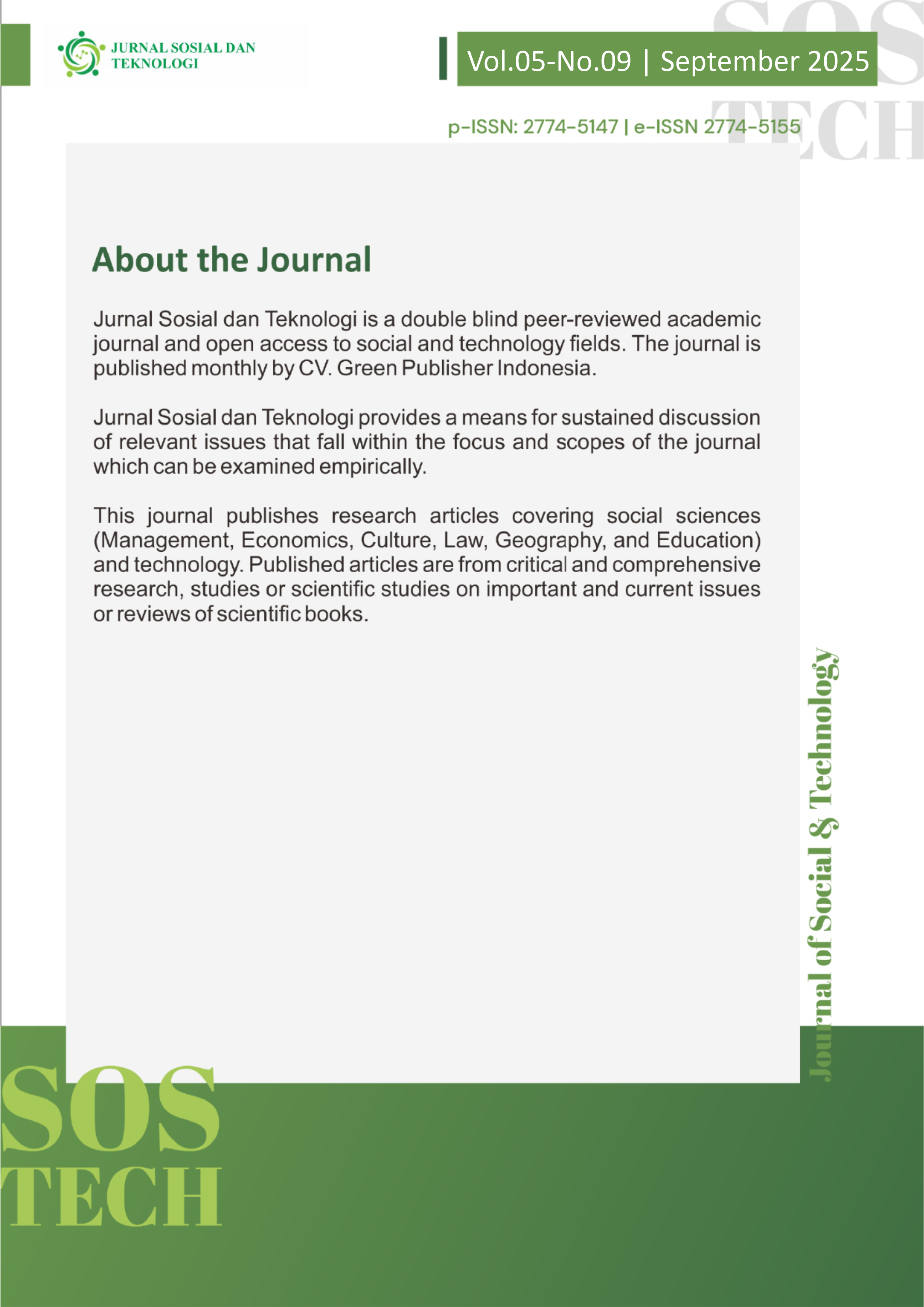Rancangan Bangun Sistem Monitoring Suhu Berbasis Internet of Things di Masjid Mudhi Ali Al-Sulthon
DOI:
https://doi.org/10.59188/jurnalsostech.v5i9.32438Keywords:
IoT, Firebase, Laravel, Room Temperature, Humidity, MosqueAbstract
As a place of worship for Muslims, a mosque is a public space used by many worshippers simultaneously. To maintain the comfort and health of worshippers, especially during extreme heat, a system capable of making automatic decisions based on real-time room temperature and humidity conditions is required. This research developed an automated Internet of Things (IoT)-based system integrated with Firebase and a Laravel-based web application. This system is designed to automatically control fans: the fans will turn on when the temperature is high and turn off when the temperature returns to normal or becomes too cold. Temperature and humidity sensors are placed at strategic points within the mosque to collect environmental data. This data is then sent in real time to Firebase and displayed on a web dashboard. The system will send notifications to the mosque management via the web dashboard and Gmail notifications if the temperature or humidity exceeds predetermined normal limits. Notifications include information on the date, day, temperature, humidity, and recommended actions. Based on this data, the system can also automatically make decisions about turning fans on or off to maintain room comfort.
References
Angriani S, Saharaeni A, Hasniati H. 2023. Metode Prototype dalam Pengembangan Sistem Informasi. Jurnal Sistem Informasi, 14(1) 12–20.
Ardiansyah MF, Handoko T. 2023. Pemanfaatan Sensor DHT11 dalam Sistem Monitoring Suhu Berbasis IoT. Jurnal Teknologi dan Inovasi Digital,5(1): 44–51.
Darwin T, Yusuf K. 2020.Penggunaan Breadboard dalam Prototipe Elektronik Jurnal Teknologi Elektronika, 4(2): 87–91.
Fadhillah M, Wibowo H. 2022. Visual Studio Code untuk PengembangannAplikasi Berbasis Cloud. Jurnal Rekayasa Perangkat Lunak, 7(3): 118–124.Hidayat A, Permana D. 2020. Dashboard Monitoring IoT dengan Laravel. Jurnal Teknologi Informasi dan Komputer, 6(1): 33–39.
Jardian J, Kevin K, Owen M. 2024. Perancangan Smart Door Berbasis ESP32 WROVER dengan Sistem Notifikasi Melalui Aplikasi Blynk. Telcomatics, 9(2): 40–46.
Juliansyah R, Fitriani E, Paramita N, Ariyadi T. 2024. Rancang Bangun Sistem Kontrol Motor Feeder dan Monitoring Pakan Ikan Nila Berbasis Smart Relay Zelio. Jurnal Pendidikan Tambusai, 8(1): 11157–11167. DOI:10.31004/jptam.v8i1.14054
Kurnia D, Risyda A. 2021. Penerapan Metode Prototype dalam Pengembangan Aplikasi Mobile. Jurnal Ilmiah Teknologi dan Sistem Informasi, 5(2): 25–32.
Muhammad C, Asran A, Multazam T. 2024. Desain Modul LCD 20x4 dan Komunikasi I2C dalam Sistem Monitoring. Jurnal Teknologi dan Robotika. 8(1): 90–98.
Prasetyo A, Nugroho B. 2021. Kelebihan Visual Studio Code dalam Pengembangan Lintas Bahasa. Jurnal Informatika dan Sistem Informasi, 6(2): 71–78.
Pratama IR, Widodo A. 2020. Fitur Autentikasi Laravel dalam Sistem Web. Jurnal Rekayasa Sistem Informasi, 5(1): 11–17.
Pramana DA, Lestari Y. 2023. Format JSON dalam Pengiriman Data Sensor IoT. Jurnal Teknologi Digital, 9(3): 110–116.
Putra AY, Sari ND. 2020. Sensor DHT11 untuk Monitoring Suhu dan Kelembaban. Jurnal Teknologi dan Sistem Komputer, 8(2): 56–62.
Putra A, Wibowo R. 2021. Pengembangan UI Responsif Menggunakan Bootstrap. Jurnal Teknologi dan Sistem Informasi, 5(4): 77–84.
Putra H, Santoso D. 2021. JSON untuk Komunikasi Data IoT. Jurnal Teknologi Internet dan Cloud, 7(1): 33–40.
Sanap VC, Nikam S, Sail V, Thorat S, Vidhate A. 2025. Design and Implementation of Real Time Clock using RTC DS3231 and Arduino Uno.International Journal for Research in Applied Science and Engineering Technology (IJRASET), 13(2): 34–38.
Santoso B, Rahmawati A. 2022. Integrasi Laravel dengan Firebase Realtime Database. Jurnal Pemrograman Web dan Sistem Informasi,6(1): 44–52.
Sari DA, Utami RN. 2021. Implementasi IoT dalam Smart City. Jurnal Rekayasa Sistem Cerdas, 5(1): 88–94.
Sari MN, Ramadhan R. 2022. Pengolahan Data JSON pada Laravel untuk IoT. Jurnal Teknologi Informasi dan Cloud Computing, 6(3): 99–106.
Sari DM, Hidayat R. 2020. Keamanan Data IoT dengan Firebase.Jurnal Sistem Informasi dan Keamanan Data, 5(2): 40–48.
Saputra D, Lestari W. 2022. Sensor DHT11 dalam Sistem IoT Berbasis Arduino. Jurnal Teknologi Mikroelektronika, 7(2): 27–34.
Siregar DR, Putra AF. 2020. Penggunaan Firebase Realtime Database untuk IoT. Jurnal Teknologi dan Sistem Komputer, 8(1): 20–27.
Suryadi A, Nugroho P. 2020. Akurasi Sensor DHT11 untuk Monitoring Suhu. Jurnal Elektronika dan Sensor, 4(3): 33–39.
Suryani N, Hartono H. 2021. Keunggulan Visual Studio Code sebagai Editor Kode. Jurnal Informatika dan Aplikasi Komputer, 6(3): 55–63.
Syahputra N, et al. 2020. NodeMCU sebagai Platform IoT Berbasis ESP32. Jurnal Sistem Embedded dan IoT, 4(2): 88–93.
Yusuf RM, WAPW. 2022. Internet of Things-based Gas Leak DetectionVia SMS and Blynk App. Sinkron: Jurnal dan Penelitian Teknik Informatika, 6(3):811–816.
Yusuf A, Ramadhan F. 2022. Monitoring Suhu dan Kelembaban Menggunakan Firebase dan Sensor DHT11. Jurnal Pemrograman dan IoT, 5(1): 70–76.
Downloads
Published
How to Cite
Issue
Section
License
Copyright (c) 2025 Arkan Ari Musyaffa, Saludin Saludin

This work is licensed under a Creative Commons Attribution-ShareAlike 4.0 International License.
Authors who publish with this journal agree to the following terms:
- Authors retain copyright and grant the journal right of first publication with the work simultaneously licensed under a Creative Commons Attribution-ShareAlike 4.0 International (CC-BY-SA). that allows others to share the work with an acknowledgement of the work's authorship and initial publication in this journal.
- Authors are able to enter into separate, additional contractual arrangements for the non-exclusive distribution of the journal's published version of the work (e.g., post it to an institutional repository or publish it in a book), with an acknowledgement of its initial publication in this journal.
- Authors are permitted and encouraged to post their work online (e.g., in institutional repositories or on their website) prior to and during the submission process, as it can lead to productive exchanges, as well as earlier and greater citation of published work.







